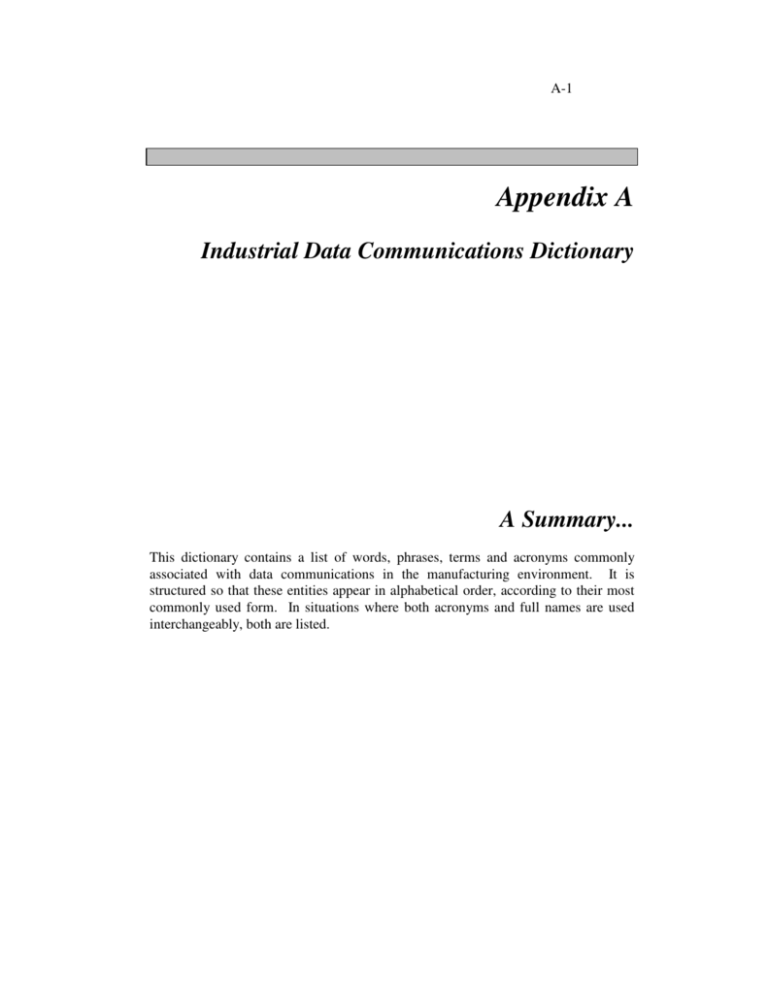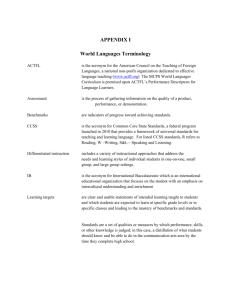Appendices - Doctortee.net

A-1
Appendix A Industrial Data Communications Dictionary A Summary...
This dictionary contains a list of words, phrases, terms and acronyms commonly associated with data communications in the manufacturing environment. It is structured so that these entities appear in alphabetical order, according to their most commonly used form. In situations where both acronyms and full names are used interchangeably, both are listed.
A-2 D.J. Toncich - Data Communications and Networking for Manufacturing Industries
ACK
The mnemonic for the ASCII character generally sent as an acknowledgment to an enquiry or message. Normally, the character with an ASCII value of decimal 6.
ACSE
Association Control Service Element. The portion of the OSI application layer that is responsible for establishing associations between application programs on network nodes.
Active Token Monitor
In the IBM token ring network, this is the name given to the node which assumes responsibility for network management.
Address
The identifier by which a node (computer) on a network is accessed. AGV The common abbreviation for Automated Guided Vehicle. A computer controlled device used to ferry parts around a manufacturing plant. ANSI American National Standards Institute - an official body dealing with standards.
Application
A piece of software that runs on a computer system.
Application Layer
Layer 7 of the OSI model. Services provided in this layer directly support user/application tasks by providing "generic" services such as remote file access, file transfer, etc.
ASCII
American Standard Code for Information Interchange. Defines all 8 bit patterns corresponding to a standard terminal character set. The standard ASCII set uses only 7 of the 8 bits in a byte, whilst the extended ASCII set defines additional characters using the 8th bit.
Asynchronous Transmission
A serial transmission scheme where the clock on the transmitter and the clock on the receiver are not directly synchronised to one another.
Appendix A - Industrial Data Communications Dictionary A-3
Backbone
The trunk media (physical layer) of a multi-media LAN separated into sections by bridges, gateways or routers. Also the main physical medium used in a network.
Background Mode
In a multi-tasking computer operating system, it represents an active task which is not visible to the user.
Band
A range of frequencies in the spectrum between two limits. Frequencies are expressed in kHz up to and including 3000 kHz; in MHz from there up to and including 3000 GHz. Thereafter tHz (teraHertz) are used.
Bandwidth
The difference in frequency between the highest and lowest frequency in a transmission channel.
Baseband
Transmission of a signal at its original frequency with pulsed modulation. Baseband signalling systems are limited to a single channel.
Basic Mode
An ISO specification for a character-oriented link level protocol.
Baud Rate
The signalling rate on a communications link. This is often confused with the number of bits per second (bit rate) because in some instances the Baud rate and the bit rate have the same value.
BCS (Block Check Sum)
A check character which represents a mathematical combination of data bits. It is transmitted following the data and is used for error checking by the recipient.
Bit Stuffing (Zero Bit Insertion)
A scheme which enables pure binary data to be transferred on a synchronous link. Data is delimited by special bit patterns and if the same patterns appear within the data then additional zero bits are inserted (stuffed) into the data by the sender.
BPS
Bits per Second - Transfer rate of a serial or parallel transmission.
A-4 D.J. Toncich - Data Communications and Networking for Manufacturing Industries
Bridge
Transparent devices used to connect similar LANs together. Networks connected by bridges would logically appear as one network.
Broadband
Use of multiple channels over the same media via frequency division of the bandwidth.
Broadcast
Transmission of a message to multiple nodes.
BSC / BiSync
Binary Synchronous Control - IBM version of the ISO Basic Mode protocol
BSI
British Standards Institute.
Bus
A collection of electrical conductors grouped together for a common purpose.
Bus Network
A topology in which information is made available simultaneously to all nodes
CAD
Acronym for Computer Aided Design
CAN
Acronym for Controller Area Network developed by Bosch and implemented in semiconductor form by Philips for automotive use.
Carrierband Transmission
Transmission of a signal at its original frequency, with frequency modulation.
CASE
Acronym for Common Application Service Elements. Service elements are entities that are used to build an applications layer (in OSI terminology). Those elements that are common to a number of applications are known as Common Application Service Elements.
Catanet
An interconnected set of networks using bridges, routers and or gateways
CCITT
Comité Consultatif Internationale de Telegraphie et Telephonie - An international consultative committee on communications standards
Appendix A - Industrial Data Communications Dictionary A-5
Centronics Port
A common type of parallel communications port generally used in conjunction with printers
Channel
That part of a communications medium that connects a transmitter to a receiver or receivers. A path for electrical transmission between two or more points.
CIM
The acronym for Computer Integrated Manufacture. The ideology which suggests that all computer based production and manufacturing management equipment should operate cohesively.
Circuit Switched Network
A network in which switches cause a physical (electrical) circuit to be established between devices for communications.
CMM
Co-ordinate Measuring Machine - A device used for metrology.
CNC
Computer Numerical Control - A specialised computer control system used to co-ordinate the operation of a machine tool such as a lathe or mill. Computer Numerical Control is also used for surface-mount technology in electronics and for sewing machine control in textiles industries. The CNC is distinguished from the older Numerical Controller (NC) by the fact that it contains an operating system, program editing and storage facilities.
Co-Axial Cable
A two-conductor cable in which a central "data-carrying" conductor is encased in a dielectric material, and then enclosed by the outer conductor in order to minimise EMI.
Connection
The communication dialogue of a pair of communication entities in the same or different processors.
Connectionless
Message transmission without the establishment of an electrical circuit. Sometimes abbreviated with CLNS (for Connectionless Network Service).
Connectivity
A characteristic of open systems such that they have the ability to pass data from one communicating entity to another.
A-6 D.J. Toncich - Data Communications and Networking for Manufacturing Industries
CPU
The common acronym for Central Processing (Processor) Unit. Normally the microprocessor chip or main processing board within a computer system.
CRC
The acronym for Cyclic Redundancy Checksum - An error detection scheme in which the check character/s are generated by taking the remainder after dividing all the serialised bits in a block of data by a predetermined binary number (CRC polynomial).
CSMA/CD
Carrier Sense Multiple Access with Collision Detection. A scheme to resolve contentions for use of communications media in a network.
Data Link
A logical connection between two stations on the same circuit. In the case of a multi-point link such as MAP, multiple data links can exist on a single circuit.
Data Link Layer
Layer 2 defined in the ISO seven layer OSI model. The data link layer establishes an error free communications path between network nodes over a physical channel; frames messages for transmission; checks the integrity of incoming messages; ensures proper sequencing of transmitted data and manages access to and use of the channel.
Data Highway
Allen Bradley proprietary Local Area Network for the manufacturing environment.
Data Units
Messages passed over connections.
DCE
Acronym for Data Communications Equipment or Data Circuit Terminating Equipment. This is a term given to modems (or other equipment provided by a public networking authority) for the attachment of user equipment to that network.
DEC
Acronym for Digital Equipment Corporation.
DECNET
Digital Equipment Corporation's proprietary Local Area Network.
Appendix A - Industrial Data Communications Dictionary A-7
Deterministic
A type of network in which delays in transmission response can be accurately predicted.
Directory Services
The LAN System function, found in the applications layer, which converts symbolic names used by applications programs into physical network addresses.
DLE
Acronym for Data Link Escape character. This character is sometimes sent to separate message data from other link control characters. It normally has the
DNA
ASCII value of decimal 16. Digital/Distributed Network Architecture - the networking architecture of the Digital Equipment Corporation.
DNC
Totally confused acronym for Distributed or Direct Numerical Control. DNC can simply refer to a CNC that can be linked to a host computer for unchecked file transfers. DNC can also infer that a Computer Numerical Control can be remotely controlled by a host computer, through a communications protocol.
DTE
Acronym for Data Terminal Equipment. The name given to devices which are connected to a network or point to point communication link.
EBCDIC
Acronym for Extended Binary Coded Decimal Interchange Code. An alternative to the ASCII code and used mainly by IBM computers other than their PC series.
ECMA
Acronym for European Computer Manufacturers Association. EIA Acronym for Electronics Industries Association. A US organisation specialising in the electrical and functional characteristics of equipment interface.
EMI
Acronym for Electro-Magnetic Interference. Electrical noise which is induced into a system as a result of magnetic fields surrounding current carrying conductors.
A-8 D.J. Toncich - Data Communications and Networking for Manufacturing Industries
ENQ
A mnemonic for the ENQuiry character, which is generally issued to establish a link. It normally has the ASCII value of decimal 5.
EOT
An acronym for the End Of Transmission character, which is sent to conclude a communications sequence. It normally has the ASCII value of decimal 4.
EPA
Acronym for Enhanced Performance Architecture. A General Motors, MAP specification for high-speed communications between low cost devices such as sensors.
Error Rate
The ratio of the mean number of corrupted data bits to the total number of transmitted data bits.
Ethernet
A XEROX, DEC and Intel implementation of the CSMA/CD contention scheme. Ethernet was the basis of the IEEE 802.3 standard. Ethernet is not a network in itself, but it is used as the basis of commercial networks which provide the upper layers of the OSI model.
ETX
A mnemonic for the End Of Text character, which is normally sent after the data portion of a message. It normally has the ASCII value of decimal 3.
Fibre Optics or Optic Fibre
Transmission of data by frequency modulated light energy within the media of a micro-diameter glass filament.
Flip-Flop
A binary storage element whose outputs can be latched into a high or low state by an external signal.
FMC / FMS
Acronyms for Flexible Manufacturing Cell or Flexible Manufacturing System. A production system in which the constituent parts are programmable, normally consisting of CNC machines, Robots, AGVs, etc.
Frame
The name sometimes given to a unit of data on a network. Packet, block and message are also used.
Appendix A - Industrial Data Communications Dictionary A-9
Frame Check Sequence (FCS)
The generic name for a bit-oriented error checking string used to trap errors in a communications link. A specific form of the FCS is called the Cyclic Redundancy Check or CRC.
Frequency Division Multiplexing (FDM)
The technique of dividing the total bandwidth of a communications medium into a number of discrete channels.
Frequency Shift Keying (FSK)
A modulation technique used to transmit binary ones with a given frequency waveform and zeros with a waveform of another frequency.
FTAM
Acronym for File Transfer, Access and Management (Manipulation). In the application layer of the OSI model, a function for file movement between open systems.
FTL
Acronym for Flexible Transfer Line. A production line with a conveyor transport system and programmable (CNC) machine tools.
Full-Duplex
A type of communication link capable of simultaneous, two way data transfer.
Gateway
A processor which acts as an interface, and protocol translator, between two totally dissimilar networks.
GPIB / HPIB
General Purpose Instrumentation Bus or Hewlett Packard Instrumentation Bus. These are implementations of the IEEE-488 parallel communications instrumentation network.
Half-Duplex
A type of communication link capable of two way, alternate data transfer. In other words, two way data transfer can occur but not simultaneously.
HDLC Hertz
Acronym for High Level Data Link Control - A Data Link Layer Protocol. A unit of frequency equal to one cycle per second.
A-10 D.J. Toncich - Data Communications and Networking for Manufacturing Industries
Host
The term normally used to describe a superior computer.
IEEE
Acronym for the Institute of Electrical and Electronics Engineers.
IEEE-488
The Standard specifying a parallel communications bus structure for instrumentation in the laboratory environment. Also known as HPIB or GPIB.
IEEE-802
A committee formed within the IEEE to establish LAN standards. The 802 standard has sections as follows: • • • • • • 802.1 - Higher Layer Interface 802.2 - Logical Link Control 802.3 - CSMA/CD 802.4 - Token Bus 802.5 - Token Ring 802.6 - Metropolitan Area Network
ISDN (Integrated Services Digital Network)
An international digital telecommunications network supporting both data and voice communications.
ISO
Acronym for International Standards Organisation
LAN
Acronym for Local Area Network. A privately owned network, offering reliable high-speed communications channels for connecting information processing equipment over a limited region.
Layer or OSI Layer
The overall networking architecture as defined by ISO is subdivided into layers. Each layer provides a set of network related services to the layer above or in the case of the top layer, to the application program. These services are provided by each layer via its programs and by the services available from the layer below or in the case of the bottom layer from the physical communications media. Messages moved between application level programs in different processors must traverse all the layers in both nodes. However, a layer may be a null layer if its services are not required.
Appendix A - Industrial Data Communications Dictionary A-11
LLC
Acronym for Logical Link Control. In IEEE terminology, the LLC constitutes the upper half of the data link layer. It is responsible for the framing of messages and the detection and correction of errors.
LON
Acronym for the Echelon/Motorola developed Local Operating Network.
MAC
Acronym for Media Access Control. In IEEE terminology, the MAC constitutes the lower half of the data link layer. It defines the techniques used to resolve contentions for use of the communications medium. Schemes include token passing and CSMA/CD.
Manchester Encoding
A technique used to encrypt timing information into data in a synchronous communications scheme.
MAP
Acronym for Manufacturing Automation Protocol. A General Motors specification based around existing and emerging international standards and based upon the OSI seven layer model
Media Access
Means by which a node gains access to a network for transmission.
Medium
Material over which information is passed (wire, optic-fibre, etc.).
MHS (Message Handling Service)
A general protocol for the applications layer that is used to facilitate electronic message interchange. It is also referred to as X.400.
Migration Path
Methodology allowing step by step implementation of emerging technology.
MMFS
Acronym for Manufacturing Message Format Standard. A complex specification for the applications layer of the OSI model. MMFS was specified
MMS
for the application layer of the MAP V2.1 protocol. Acronym for Manufacturing Message Standard. A modular specification for the OSI application layer, based upon the definition of Virtual Manufacturing Devices. MMS is specified for the application layer of MAP V3.0.
A-12 D.J. Toncich - Data Communications and Networking for Manufacturing Industries
MODBUS
Gould-Modicon Corporation's Industrial Local Area Network.
Modem
Modulation/Demodulation device. A device that translates signals from digital form to a form suitable for transmission over communications lines and then back to digital.
Multidrop
A communications scheme in which a single transmission medium supports multiple nodes (compared with point to point links).
Multiplexer (MUX)
Electrical Engineering term for a switching device.
NAK
Mnemonic for Negative Acknowledgment. Normally sent by a device which has detected an error in message reception. It generally has the ASCII value of decimal 21.
NAU
Acronym for Network Addressable Unit. A basic node in IBM Corporation's SNA networking structure.
NBS
Acronym for National Bureau of Standards. An American standards body.
NC
Numerical Control. An early form of machine control system generally based upon paper-tape programming. The precursor to CNC.
Network
An interconnected group of computer-based nodes.
Network Layer
Layer 3 of the OSI model. Controls message flow between nodes and performs addressing, routing and path set-up services.
Neuron Chip
A multi-processor VLSI device which is Motorola's implementation of all seven layers of the Echelon LON Works network protocol.
NIU
Acronym for Network Interface Unit. Translates from device bus structure or protocol to the network protocol.
Appendix A - Industrial Data Communications Dictionary A-13
Node Address
A unique address for each device on a LAN.
Noise
(i) Term given to spurious electrical signals induced in a communications link. (ii) The signal level at which there is no discernible information
NRZ/NRZI (Non-Return To Zero)
Two similar schemes for encoding clocking information into data within a synchronous communications link.
Null Layer
A layer in the OSI system which provides no additional services and exists only to provide a logical path for the flow of network data and control.
Ones' Complement
In binary arithmetic, the one's complement of a number is achieved by reversing the status of every bit in the number. For example, the one's complement of binary 01100011 is binary 10011100.
Open System
(i) A computer based apparatus which is fully software programmable. (ii) A computer processor or connected set of processors with software support that allows an application entity running in the open system to communicate with other application entities running on the same or other open systems.
Open Systems Network
A series of connected open systems whose applications have connectivity with each other in a peer to peer relationship. Each system in an open systems network provides common services and related protocols.
Optic Fibre Cable
A glass filament cable in which data signals (pre-converted from electrical signals into light pulses) can be transmitted without susceptance to EMI.
OSI
Acronym for Open Systems Interconnection - An ISO developed, seven layer model for communications.
OSIE
Acronym for Open Systems Interconnection Environment.
PABX
Acronym for Private Automatic Branch Exchange. A device used to electronically interconnect different nodes.
A-14 D.J. Toncich - Data Communications and Networking for Manufacturing Industries
PAD
Acronym for Packet Assembler-Disassembler. Used in conjunction with the X.25 packet switched network.
PAL
Acronym for Programmable Array Logic. A digital technology that enables complex Boolean circuits to be implemented on a single chip by end users. A similar (but not identical) technology to PLA.
PBX
Acronym for Private Branch Exchange - usually associated with telephones
PC
Acronym for Personal Computer
PD
Acronym for Programmable Devices (PLCs, Robots, CNCs, PCs)
PDU
Programmable Data Unit - A unit of data specified in a protocol and consisting of protocol control information and possibly user data. The total information that is transferred between peer entities as a unit.
Peer Network Device
Any device directly attached to the MAP local area network which contains a system manager and has transport layer functionality.
Phase Shift Keying (PSK)
A modulation technique in which ones are represented by a waveform of a given phase and zeros are represented by a waveform of a different phase.
Physical Layer
Layer 1 of the OSI model. The physical layer defines the electrical and mechanical aspect of interfacing to a physical medium for transmitting data, as well as setting up, maintaining and disconnecting physical links. Physical hardware in this layer includes interface devices, modems and communications lines. Software to control the communications devices is also included.
PLA
Acronym for Programmable Logic Array. A digital technology that enables complex Boolean circuits to be integrated on a single chip by end-users. Similar (but not identical) to PAL technology.
Appendix A - Industrial Data Communications Dictionary A-15
PLC
Programmable Logic Controller. An industrial computer control generally used for sequential systems.
Point To Point Link
A single communication link with a device at each end.
Presentation Layer
The sixth layer of the OSI model, designed to control the presentation of data to the application program.
Print Spooler
Software or hardware that creates a buffer where files to be printed are held until they are processed.
Protocol
In communications, a set of rules (specifications) which strictly define the way in which data transfer is to occur between devices on a link or network.
Public Switched Data Network (PSDN)
A communications network established by a public body for the purpose of interchanging digital data over large distances.
Public Switched Telephone Network (PSTN)
An analogue communications network set up for voice communications and capable of supporting data communications through the use of modems.
QPSK
Acronym for Quadrature Phase Shift Keying. A modulation technique derivative of PSK.
Register
A collection of flip-flops grouped together for some common purpose.
Response Time
Waiting time between request for use of a network and the time at which requested service is provided.
Ring Network
A topology in which information is passed from node to node in a logical loop.
Router
A device that performs translations between the lower 3 layers of multiple, dissimilar LANs.
A-16 D.J. Toncich - Data Communications and Networking for Manufacturing Industries
Routing
A function within a layer that translates the name of an entity, or the service access point address to which it is attached, into a path by which the entity can be reached.
RS-232
Electronics Industries Association standard governing hardware and hand shaking for serial devices.
RS-422
A balanced wire-pair signalling system that can be used for serial communication with greater noise immunity than RS-232.
RS-449
A communication standard based upon RS-422 signalling.
SDLC
Acronym for Synchronous Data Link Communication. IBM version of synchronous, serial data-link level protocol which is almost identical to HDLC.
Services
The functions offered by an open system to communicating entities in adjacent layers.
Session Layer
Layer 5 of the OSI model. Establishes and controls system-dependent aspects of communications sessions between specific nodes, bridging the gap between services provided by the transport layer and functions provided by the operating system of the node.
Simplex Link
A link which is only designed for one way data transfer.
SNA
Acronym for Systems Network Architecture - the IBM Networking architecture.
Star Network
A topology consisting of a central node with radiating link elements.
Statistical (Non-Deterministic) Network
A network in which response varies probabilistically with data traffic conditions.
Appendix A - Industrial Data Communications Dictionary A-17
STX
Mnemonic for the Start of Transmission character, which usually precedes the data field in a message. It normally has the ASCII value of decimal 2.
Sub network (MAP)
A MAP compatible, bridge accessible sub network. Logically both the backbone and the sub network look like one network.
Synchronous Communications
A serial communications scheme in which clocking information from a transmitter is either encrypted into data or else fed directly to a receiver for extraction and synchronisation.
System Manager (MAP)
Resides in all MAP nodes and is responsible for interfacing with Network Management to provide information or to execute network management functions. The level of functionality resident within a system manager is dependent on the class of node and the specific vendor implementation.
Terminal
Text input/output device - VDU/Printer, etc..
Throughput
Measure of the aggregate amount of data a network can carry in a given time.
TIM
Token Bus Interface Module. An external processor which provides layers 1 and 2 of the MAP protocol.
Time Division Multiplexing (TDM)
A scheme in which the total bandwidth of a communications medium is shared by multiple channels, through time-slicing of data.
Token
Special bit patterns or packet that travels on a token access network (token bus or ring) from node to node, giving the node in possession of the token exclusive access to the network for transmission. The token is passed on if it has nothing to transmit, otherwise it is held until transmission finishes or a time-out occurs.
Token Bus
A network architecture based on a bus topology and using a token based media access method.
A-18 D.J. Toncich - Data Communications and Networking for Manufacturing Industries
Token Ring
Network architecture using ring topology and a token based media access method.
TOP
Acronym for Technical Office Protocol. Developed by Boeing, in line with the OSI seven layer model, and designed to complement the GM MAP protocol.
Topology
Basic shape of an interconnection scheme for a network. Transport Layer Layer 4 of the OSI model. Providing end to end control of a communication session once a path has been established, allowing processes to exchange data reliably and sequentially, independent of systems communicating or their location in the network.
Twisted-Pair
A cabling system in which internal conductors are twisted around one another (in pairs) to minimise cross-talk interference effects.
Two's Complement
In a computer system, the two's complement of a number represents the negative of that number. The two's complement is obtained by reversing the status of every bit in a binary number and then adding 1 to the result. For example, the two's complement of binary 01100011 is binary 10011101.
UART
Acronym for Universal Asynchronous Receiver Transmitter. A circuit used for serial/parallel and parallel/serial conversion in an asynchronous communications link.
UNIX
A widely used multi-tasking, multi-user operating system from which the DOS system was initially developed. USRT Acronym for Universal Synchronous Receiver Transmitter. A circuit used for serial/parallel and parallel/serial conversion in a synchronous communications link.
User Program
A computer program running in a processor that performs information processing for some specific use.
Appendix A - Industrial Data Communications Dictionary A-19
Virtual Terminal (VT)
A part of the protocol of the applications layer. It allows an application program on one node to communicate with a remote terminal in a standardised fashion.
VLSI
Acronym for Very Large Scale Integrated Circuit. A semiconductor fabrication technology by which a high component density can be achieved on the bulk material.
Wide Area Network (WAN)
Any public or private network which covers a large region.
X.25
CCITT communications recommendation defining the connection of a computer to a packet switched network.
XOFF
Mnemonic for the "Stop transmission" character. It normally has an ASCII value of decimal 19.
XON
Mnemonic for the "Resume transmission" character. It normally has an ASCII value of decimal 17.
A-20 D.J. Toncich - Data Communications and Networking for Manufacturing Industries
B-1
Appendix B References A Summary...
For basic concepts and direct instruction on RS-232 communications and hardware hand-shaking, the following book is recommended as a good handbook:
CAMPBELL, J. The RS-232 Solution. Sybex Computer Books, 1986.
For advanced concepts and theory in computer networking (Local and Wide Area Networks) the following book is recommended as a high quality text:
HALSALL, F. Data Communications, Computer Networks and OSI. 2nd Edition, Addison Wesley, 1988.
B-2 D.J. Toncich - Data Communications and Networking for Manufacturing Industries [1] BLANC, R.P., "Local Area Network Standards", Proc. IEEE Computer Society COMPCON Spring 1984, pp252-260. [2] BUCZKOWSKA, T. "Computer Networks",Journal of Electrical and Electronics Engineering, IE Aust. & IREE Aust., Vol. 6, No. 4. December 1986, pp259-269. [3] [4] CAMPBELL, J., "The RS232 Solution", Sybex Computer Books, 1986. CLEAVELAND, P., "Local Area Networks for Industrial Control", The Industrial and Process Control Magazine, August 1984, pp31-56. [5] COHEN, P.A., "Trends in Flexible Manufacturing Systems", Proc.CIMCOM'85 Conference,Anaheim California, April 1985, pp1-14. [6] CROOKS, P., "Chip and Board Level Support for Token Bus and GM MAP", Electronic Engineering, March 1986, pp37-42. [7] CROWDER, R.S., "Enhanced Performance MAP", SME MAP/TOP Interface, August 1986 & November 1986. [8] CROWDER, R.S., "Putting MAP/TOP Products in Perspective", I&CS Magazine, November 1986, pp49-69. [9] FAROWICH, S.A., "Communicating in the Technical Office", IEEE Spectrum, April 1986, pp63-67. [10] GOFTON, P.W., "Mastering Serial Communications", Sybex Computer Books, 1986, pp135-137. [11] HALSALL, F., "Data Communications, Computer Networks and OSI", Second Edition, Addison Wesley, 1988. [12] HAMMOND, J. L. and O'Reilly, P.J.P., "Performance Analysis of Local Computer Networks", Addison Wesley, 1986. [13] HOLLAND, J.R. "Factory Area Networks - The Key to Successful Factory Automation Strategies", Proc. SME AUTOFACT Europe Conference 1983, pp35-51. [14] HUGHES, K. and Floyd, R., "Data Communications Standardization within Manufacturing", Proc. IEEE Computer Society COMPCON Spring 1984, pp266-269. [15] IEEE, "Logical Link Control - IEEE 802.2", IEEE Publication 1985.
Appendix B - References B-3 [16] IEEE, "CSMA/CD Access Method - IEEE 802.3", IEEE Publication 1985. [17] IEEE, "Token Bus Access Method - IEEE 802.4", IEEE Publication 1985. [18] IEEE, "Token Ring Access Method - IEEE 802.5", IEEE Publication 1985. [19] KAMINSKY, M. A., "Protocols for Communicating in the Factory" IEEE Spectrum, April 1986, pp56-62. [20] KAMINSKY, M., "MAP and TOP Information Package", GM MAP/TOP Task Force Publication, 1986. [21] KOLODZIEJ, S., "MAP Moves off the Drawing Board", The FMS Magazine, October 1986, pp185-187. [22] MICHELETTI, G.F., "Some Problems in Design of Flexible Manufacturing Systems", Annals of the CIRP, Vol. 32/1/1983, pp417-421. [23] MOTOROLA CORPORATION, "LONWORKS Product Line Brief", 1990, Echelon Corporatioin, USA. [24] NICOLETTI, G.M., "CIM: LAN Communications, Protocol Standards and Real-Time Control", Proc. AUTOMACH 86, Sydney Australia, May 1986, pp1-36. [25] RAAB, A., " CAN - Controller Area Network", Elektor Electronics, International Electronics Magazine, Volume 18, Number 203, September 1992 [26] RANDAL, D., "The Industrial Implications of Flexible Machining", Robotics Magazine, November/December 1985. [27] SCHATT, S., "Understanding Local Area Networks", Howard W. Sams and Company, 1988. [28] SINGH, I.M., "Implementation of Standard LAN Protocols - Tools for Development and Verification", Proc. IEEE Computer Society COMPCON Spring 1984, pp261-265. [29] STRASSER, T.D., "MAP/TOP - Overcoming Barriers to Integration", Journal of Electrical and Electronics Engineering Australia, IREE, IE Aust College of Electrical Engineers, Volume 9, No. 4, December 1989 [30] TONCICH, D.J., "CNC Philosophy Outmoded", Process and Control Engineering Magazine, September 1988, pp66-70.
B-4 D.J. Toncich - Data Communications and Networking for Manufacturing Industries [31] TONCICH, D.J., "Development of a Flexible Transfer Line for Australian Industry, Based Upon the Use of Standardised Machining Modules", Proc. MECH. 88 Conference, Brisbane, May 1988. [32] VAUGHN, R.L., "Integration at Work", Computers in Mechanical Engineering, November 1985, pp43-49.






